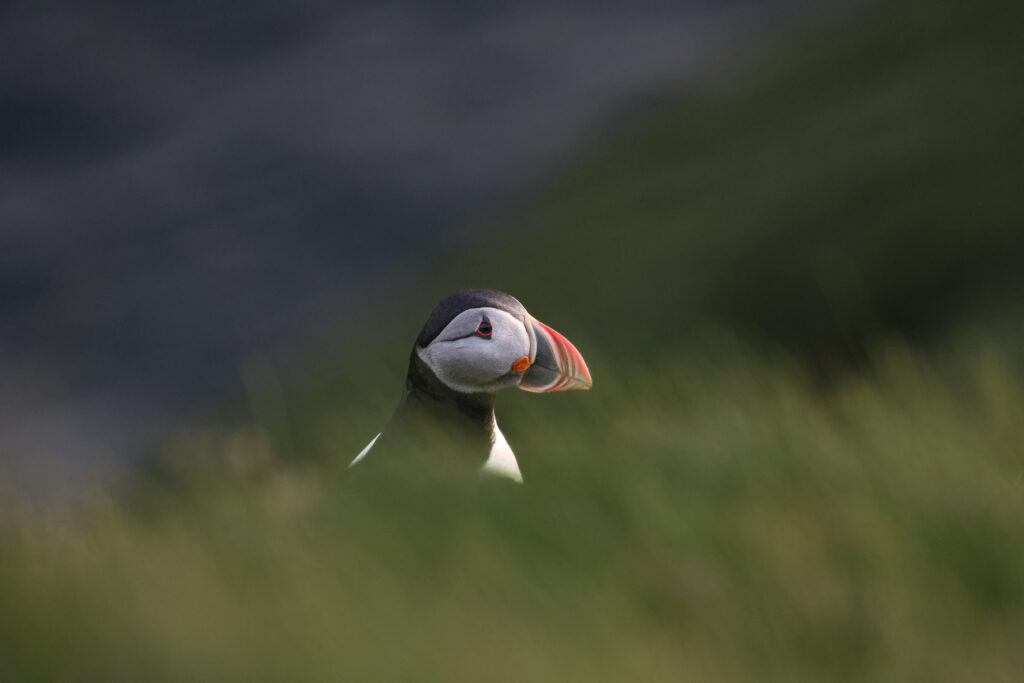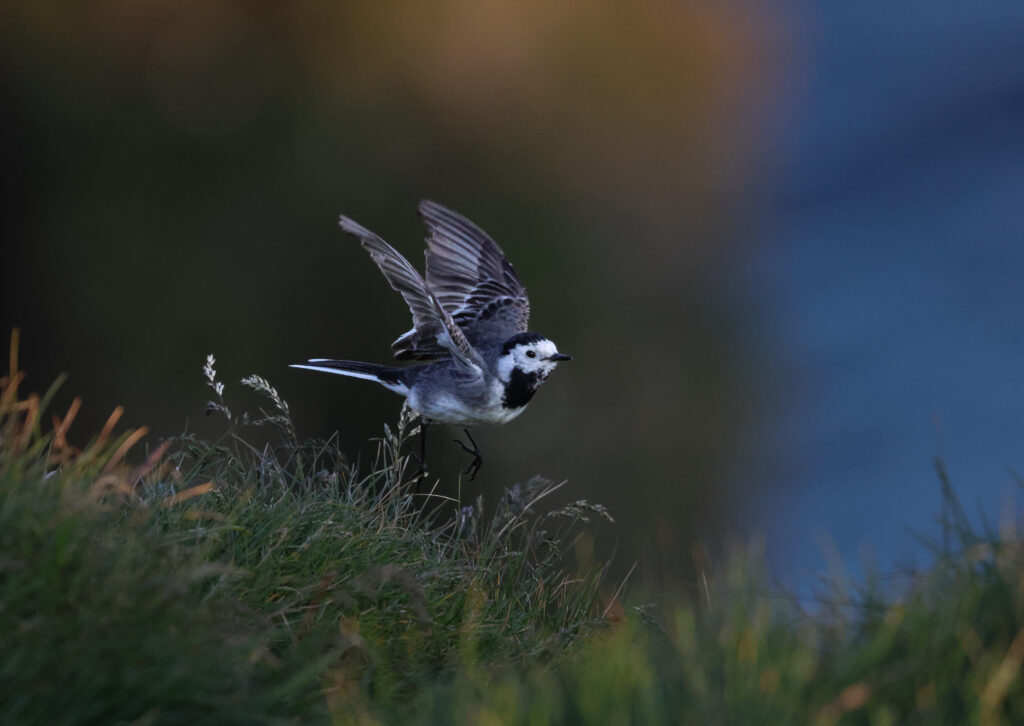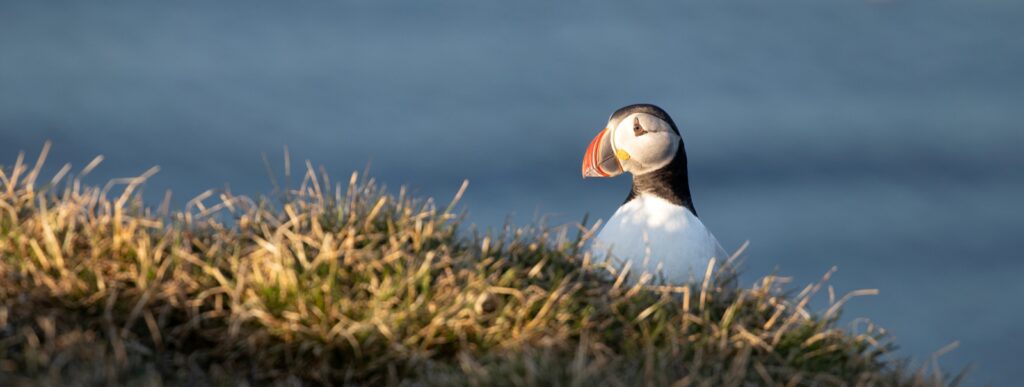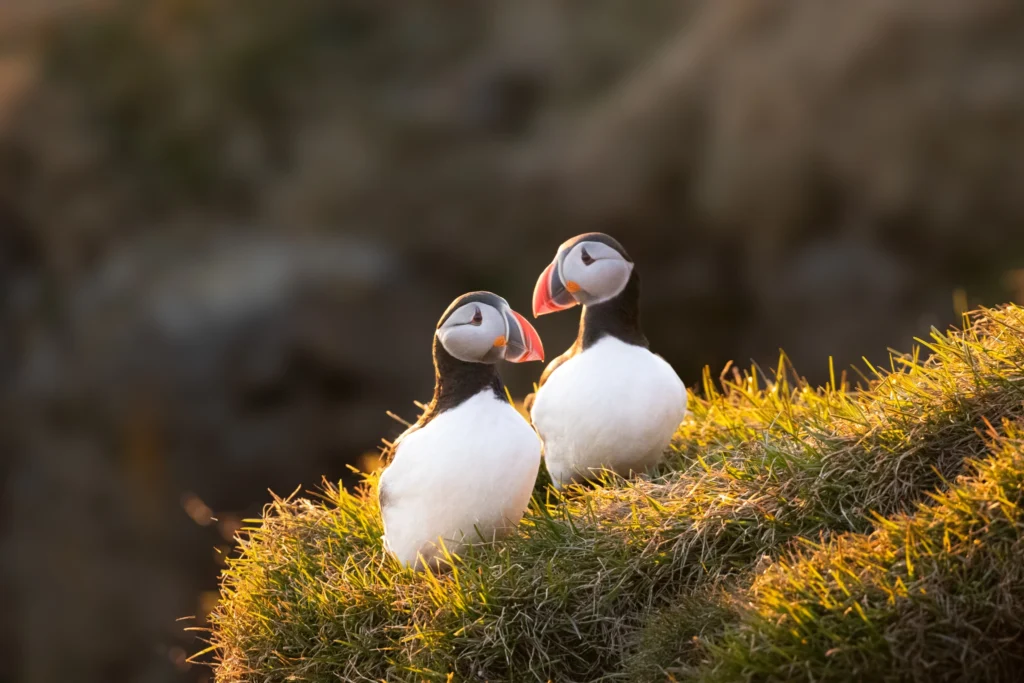Do you want to photograph puffins in Iceland but can’t decide which island to choose? I got you covered in this side-by-side comparison of the two most popular places in Iceland for puffins!
Like many other places in Iceland, this scene was otherworldly. Long grass glowed golden in the midnight sun as I walked along a narrow dirt path towards the cliffs. In the distance, the sky turned sunset colors. Light rippled across the blue ocean between the islands of Surtsey and the other smaller islets.
Above me, the whimsical sound of the Common Snipe’s tail feathers filled the silence. I slipped my lopapeysu over my head to ward off the slight chill in the air. Crouching within a familiar spot, I spotted the first puffin peeking out from a patch of green. Before releasing the shutter, I paused to take it all in.
Seated alone on this tiny archipelago, my only company the snipe and the puffin, I had never felt so at ease.
One of my favorite subjects to photograph in Iceland is the Atlantic puffin. Colorful, clownish, tough, and full of personality, these resilient sea birds make their annual migration to Iceland’s coast for the breeding season and in the process, steal our hearts.
Atlantic puffins spend most of their lives in the ocean, until April when they arrive on land for breeding. Puffin season in Iceland is from mid-April to approximately early August, after their fledglings have left the nest.
The best time to visit Iceland to photograph puffins is late April through early August.
Interesting Facts about Puffins
Puffins mate for life, but only spend their breeding season with their mate. In April, they reunite at their burrows and engage in a “billing ritual” where they rub their bills together as a courtship practice. Once breeding season ends, they return to the ocean alone.
The male puffin arrives at the burrow first to prepare it. If his mate does not return, he will take a new mate, but if the original female returns, he will kick out the new mate! Talk about faithfulness!
Puffins, although they live on land in colonies for protection, are solitary birds on the sea, traveling to the North Atlantic to spend winters alone diving for fish.
Puffins only have their signature bright beak during the breeding season. Once it ends, they shed their beak, and it is replaced by a plain black one.
Puffins feed primarily on sand eels and small fish. They are exceptional divers and can dive up to 60 meters!
Puffins have only one chick per pair. When the chicks are born, they are born with a plain black bill, which remains until breeding season. They are cared for by both parents and stay in their burrow for up to 45 days.
Although puffins are not endangered, their population is declining due to hunting, unethical fishing practices, and loss of habitat due to land development.
Westman Island
An island rich in nature with an intriguing history.
Westman Islands are an archipelago off Iceland’s south coast. Formed by submarine eruptions, Westman is rich in volcanic history and home to one of Iceland’s longest-lasting eruptions, Surtsey.
The largest island, Heimaey, has a population of 4,500 and is the only inhabited island. This is where you will sail to and is known as the “main island.” Included in Westman are 15 islands and 30 skerries, creating a rich seabird habitat and a unique, biodiverse environment. Surtsey, the newest island to emerge in the 1960s because of an eruption, is listed as a UNESCO World Heritage site.
To reach Westman, you can sail with the ferry Herjólfur from Landeyhöfn. There is a campground, and several places to book a stay, as well as scooter rentals if you choose not to bring a car. I sailed with a camper van, since I was camping and enjoyed having the transportation to the island’s southernmost point to see the largest colony, Stórhöfði.
Pros
Views and more views. Epic views from Stórhöfði and unforgettable sunsets. There is also a lovely path along the coast by the golf course where you can spot Oystercatchers and other seabirds.
More to do than just puffins, Westman is brimming with fun activities such as a rib safari boat ride, two incredible bakeries, plenty of hikes, such as the volcano Helgafell, a Viking museum, the infamous elephant rock, and even golf! If you are traveling with a non-photographer companion or family, this may be a better option, or if you are interested in exploring these activities on your own. On a sunny summer day in Iceland, Westman is the place to be to ask a local! It is also worth hiking Eldfell, the island’s last eruption in 1973, and touring the museum. There is also a grocery store, a bank, a gas station, and a post office.
Perfect for camping, Westman has one campsite that is split into two locations. I have camped at the one tucked in the valley, and to be honest, it has been one of my favorite campsites in Iceland! The showers are clean, the hosts are hospitable, the kitchen is roomy, and the site itself is tranquil! Bonus, there is a quaint but informative Viking museum inside a turf house onsite that, for a small fee, you can tour. The museum tells the story of local settlers as well as Iceland’s first settlers, Floki and his three ravens.
A short sail to reach Westman, averaging 40 minutes, this sail is way less daunting than the 3-hour boat ride to Grimsey. The boat leaves from Landeyhöfn, which is about a 2-hour drive from Reykjavik, making it much more accessible for folks flying into Keflavik. During inclement weather, the ferry may be rerouted to Þorlákshöfn, which is a 2-hour sail.
Friendly locals. I have found the locals in Westman to be friendly, hospitable, and helpful! One summer, I was invited to assist in the annual “throwing baby puffins” into the sea practice where locals of Westman collect baby puffins lost on land and throw them off the cliff so they can find their way back to the ocean! If you visit Iceland in August, be sure to bring along a cardboard box and a flashlight to go looking for baby puffins at night!
Cons
There are no real cons to visiting Westman. Every time I have been to Westman, I enjoyed my visit. It is a popular destination for locals to visit and spend a sunny day. No matter the time or activity, Westman is sure to be a stop in Iceland you will remember! However, there are a few things I wanted to point out if you are torn between Westman and Grimsey.
In comparison, there are many more puffins on Grimsey Island. You also have a higher chance of running into other photographers and tourists here. For the most part, there are not many visitors here, but you may encounter a few. This can be very pleasant and lead to a new friendship. Fellow puffin watchers have been courteous, and I have even had a few late nights and early mornings all to myself!
The sail can be rough. I have had mostly smooth sails to Westman, but once a very rough one. Sails can, on occasion, be cancelled or rerouted in case the current is too strong. Be prepared for this to happen if the weather looks windy, or reschedule for another day. Remember, in Iceland, nature rules, so it’s always good to arrive with a backup plan and bring your sense of adventure.
Summary: The Westman Islands offer visitors and photographers a chance to experience Iceland’s rich volcanic history, unique biodiversity, and see puffins and other seabirds with a short sail from the well-traveled south coast.
Grimsey Island
Step onto a remote island rich in nature that makes you feel as if you are at the end of the world.
Way north of Eyjarfjörður is the island of Grimsey, a small, loosely populated island that is part of Iceland and within the Arctic Circle. Grimsey Island is about as remote as it gets. Under 100 hardy Icelanders inhabit the island, along with millions of puffins and other seabirds, such as the courageous Arctic Terns and curious Fulmars.
There is not much to do on Grimsey, making it the perfect destination for folks interested in nature, legends, crossing the Arctic Circle, and, of course, puffins. The Atlantic puffin is often spotted earlier than anywhere else in Iceland, sometimes even in early April!
There are two options to reach Grimsey. First, you must get to Akureyri, a city in North Iceland. From there you can take a flight with, or the ferry Sævar from Dalvík. There is a bus route 78 that leaves from the Hof cultural center in Akureyri and will take you to Dalvik. I took a taxi from the neighboring town of Árskósgssandur. The ferry is a 3-hour one-way trip and can get rough, so a flight is best for those with extreme sea sickness.
Pros
There. Are. So. Many. Puffins. Really. Millions. Want a photograph of a puffin against the blue sea? In green grasses? Against the sunset or at golden hour? Your options are endless, which is why it is best to go with a plan. Otherwise, you may be overwhelmed at how many puffins there are and have no idea where to start!
You get to cross the Arctic Circle, and this is cool. The magnetic marker for the Arctic Circle changes, and this large round sculpture is moved to reflect the location change. Experts say one day it may end up in the sea!
Landscapes. There is not much here besides the deep blue North Ocean, craggy cliffs, golden grasses, sheep, and puffins, but do you need anything else for some incredible compositions? No! I especially loved the sunset here and hiking to the northern tip. You get the sense of how vast the horizon and the sea are!
Friendly locals. Just like in Westman, the locals here are friendly and helpful. The restaurant owners were super hospitable and accommodating, as was my host at the Sol Guesthouse. One neat thing about visiting these off-the-grid places in Iceland is that you get a first-hand experience with Icelandic culture. Locals are working at a slower pace, speaking Icelandic, and are more likely to have the time for a conversation.
The sense of remoteness. Here on Grimsey you feel how remote it is as soon as you step onto the island. I was overwhelmed with this incredible feeling when I hiked North on the island and looked out at the sea. It was a truly remarkable moment that I will never forget.
Cons
Like Westman, there are no real “cons” to visiting Grimsey. I have yet to meet a person who regretted the long way to Grimsey, and I was happy I opted to stay at least one night- in fact, I would like to return. But here are a few things about Grimsey you may want to be aware of.
The way there. If you are flying into Keflavik, you still must get to the Reykjavik domestic airport to reach Akureyri. It may take a few days to reach the remote Grimsey, but it is well worth it!
Not much to do besides, well, see puffins. There is a beautiful lighthouse, a museum, and a small craft store, but in terms of comparison to Westman, you are limited to one grocery store and one restaurant. No big deal if your objective is to do photography and be immersed in nature. Be prepared for an overnight stay by bringing snacks, groceries, and other essentials for food. This is a slower way of traveling, so be sure to bask in the precious simplicity of Grimsey! There is also an indoor pool and sauna, perfect for a swim and a genuine connection to Icelandic bathing culture.
Limited places to stay, but you can camp! There are three guesthouses on Grimsey, and all have great reviews. I stayed at Gullsól near the harbor, which was lovely, but the upstairs is very tight. I was the only one there, so it was a quiet stay, but it may be different with a large group of strangers. The campground is located by the swimming pool, and the campground fee includes access to the swimming pool. My advice is that if you are looking to travel during peak travel times, it is advisable to book ahead during peak travel times, as accommodations are limited on this little island.
The most common question I get is, “Is it worth it to stay on Grimsey overnight?” If your objective is photography, then YES. The Golden hour and sunset light are magical, and sunrise is beautiful too. I wish I had stayed two nights.
In closing, whichever island you choose for your puffin adventure, you can’t go wrong! Wildlife photography is unpredictable, which is what makes it such an adventure. My advice is to visit both places to experience the unique part of going the lesser-traveled paths in Iceland. You will never forget it. Westman Island and Grimsey have both given me moments that will remain in my heart and mind forever.
So whether you will be walking the dirt path at sunset to see puffins on Westman or crouching beside the sea cliffs on Grimsey to get that perfect golden hour shot, remember to pause before you hit the shutter and take it all in.
Links you may need:
Other recommended activities nearby:
South Coast of Iceland
Tour the unique highlands with Midgard Adventure out of Hvosvöllur
Connect with an Icelandic horse and the Viking way on Mr Iceland
Tour the Diamond Circle of the North out of Akureyri
Take a sail to visit the jewel of the north, Hrísey, out of Árksgossandur











